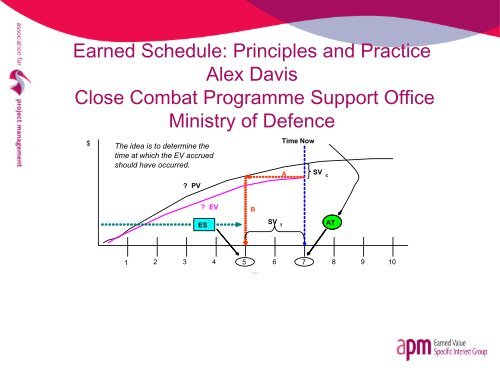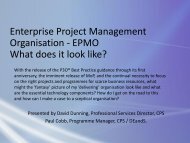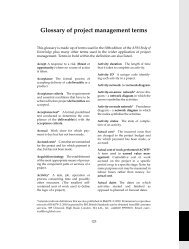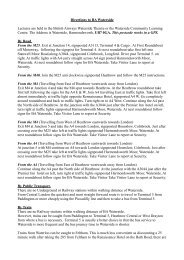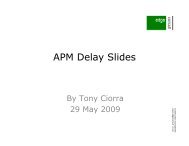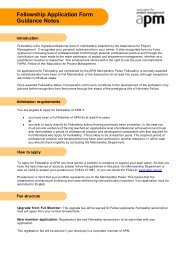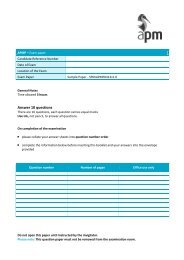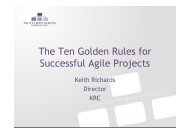Earned schedule: principles and practice - Association for Project ...
Earned schedule: principles and practice - Association for Project ...
Earned schedule: principles and practice - Association for Project ...
- No tags were found...
You also want an ePaper? Increase the reach of your titles
YUMPU automatically turns print PDFs into web optimized ePapers that Google loves.
Introduction• What is <strong>Earned</strong> Schedule?– History <strong>and</strong> background• What are the benefits of using <strong>Earned</strong> Schedule?• How does <strong>Earned</strong> Schedule work?• What are the similarities <strong>and</strong> differences between<strong>Earned</strong> Value <strong>and</strong> <strong>Earned</strong> Schedule?• How can <strong>Earned</strong> Schedule be integrated with other<strong>Project</strong> Management techniques?• Sanitised examples:
Playing Devil‟s Advocate• Why do I need another project management tool?• I‟ve already got a link between cost <strong>and</strong> <strong>schedule</strong>!• Does this technique REALLY provide better decisionmaking?• I‟ve heard this technique is used on developmentprojects…but does it work <strong>for</strong> ongoing operations?• Are you saying that <strong>Earned</strong> Value doesn‟t work!?
Playing Devil‟s Advocate (2)• It‟s good as a <strong>Project</strong> management technique…however…– „Classical‟ <strong>schedule</strong> indicators are not accurate <strong>for</strong> late finish projects– Schedule per<strong>for</strong>mance analysis is limited in some areas– Some EVM practitioners pay attention to Cost – not always the<strong>schedule</strong>– EVM has, in some areas, become focused in financial management– Indicators are not directly connected to deliverables– EV is not required to be synchronous with the <strong>schedule</strong>– EVM offers a limited decision-making guidance <strong>for</strong> project <strong>schedule</strong>control
<strong>Earned</strong> Schedule – a brief history• The original phrase “Time is money” was first posed by Antiphon– Greek writer <strong>and</strong> educator– Around 430 BC– “The most costly outlay is time”• This statement was ahead of its time!• In 2006, Dr. Steve Gumley, CEO Defence Materiel Organisation(Australia) stated…“We need to maintain our attention on <strong>schedule</strong> delivery. Datatells us that since July 2003, real cost increase in projectsaccounted <strong>for</strong> less than 3 percent of the total cost growth.…There<strong>for</strong>e, our problem is not cost, it is SCHEDULE.”
<strong>Earned</strong> Schedule – a brief history• <strong>Earned</strong> Schedule papers first published in USA– in 2003• “Schedule is different”, Measurable News• Concept was verified with actual project data• Continued development from 2003 to present
Benefits of using <strong>Earned</strong> Schedule (1)• You only need PV, EV <strong>and</strong> AT to per<strong>for</strong>m calculations!• Improves decision making – part of <strong>Project</strong>, Programme<strong>and</strong> Enterprise Management toolset• Integrates <strong>and</strong> supports risk management activities• Connects EVM to the project <strong>schedule</strong>• <strong>Project</strong> Managers have a <strong>schedule</strong> analysis tool thatimproves the confidence in <strong>for</strong>ecasting delivery dates• Adds to trend analysis
Benefits of using <strong>Earned</strong> Schedule (2)• ES can be applied to any level of the WBS, to include taskgroupings such as the Critical Path– Requires creating PMB <strong>for</strong> the area of interest– EV <strong>for</strong> the area of interest is used to determine its ES• Enables comparison of <strong>for</strong>ecasts, total project duration (TP)to Critical Path (CP) duration– Desired result: <strong>for</strong>ecasts are equal– When TP <strong>for</strong>ecast > CP <strong>for</strong>ecast, CP has changed– When CP > TP, possibility of future problems
Benefits of using <strong>Earned</strong> Schedule (3)• <strong>Earned</strong> Schedule works!• How do we know?• Evidence from a number of projects• IEAC(t) & SPI(t) studies by K. Henderson, Dr.Vanhoucke & S. V<strong>and</strong>evoorde (2003 – present)– Henderson & V<strong>and</strong>evoorde validated ES concept with real data– Using simulation Vanhoucke & V<strong>and</strong>evoorde showed ES to be abetter <strong>schedule</strong> predictor than other EVM-based methods• “The results ..confirm ..that the ES method outper<strong>for</strong>ms, on average,the other <strong>for</strong>ecasting methods” - Vanhoucke & V<strong>and</strong>evoorde• Takes <strong>Earned</strong> Value Management into a new dimension
Why use <strong>Earned</strong> Schedule?• Schedule Variance (SV) <strong>and</strong> Schedule Per<strong>for</strong>manceIndicator (SPI) behave erratically – especially <strong>for</strong>projects behind <strong>schedule</strong>• SPI improves <strong>and</strong> concludes at 1.00 at end of project• Why is this?• EV=BAC at completion• PV=BAC at completion• Hence SPI(£)=1 <strong>and</strong> SV(£) = 0• Classical Schedule Variance is measured in money –not time!
Dollars (,000)WeeksComparison of Schedule VariancesCommercial IT Infrastructure Expansion <strong>Project</strong> Phase 1Cost <strong>and</strong> Schedule Variancesat <strong>Project</strong> <strong>Project</strong>ion: Week Starting 15th July xxCV cum SV cum Target SV & CV SV (t) cum200-20-4020-2-4-60-6-80-100-120-140-1601 2 3 4 5 6 7 8 9 10 11 12 13 14 15 16 17 18 19 20 21 22 23 24 25 26 27 28 29 30 31 32 33 34Elapsed Weeks-8-10-12-14-16Copyright Lipke 2008
<strong>Earned</strong> Schedule Calculation• ES (cumulative) is the:Number of complete PV time increments EVequals or exceeds PV + the fraction of theincomplete PV increment• ES = C + I where:C = number of time increments <strong>for</strong> EV(BCWP BCWS)PVI = (EV – PV C ) / (PV C+1 – PV C )
EVM & ES Duration ForecastingThe ES idea is to determine thetime at which the EV accruedshould have occurred.ActualTimePVcumEV cum£SV cSV t<strong>Earned</strong>Schedule1 2 3 4 5 6 7 8 9 10Time PeriodsTime based <strong>schedule</strong> per<strong>for</strong>mance efficiency: SPI(t) = ES / ATCopyright Lipke 2008
Calculating the Increment IPV CPV C+1MONEY (£)PV C+1 – PV CEV – PV C5 6I - expressed as a fraction of timeTime PeriodsCopyright Lipke 2008
Calculating <strong>Earned</strong> Schedule (1)1st value EV < PVDenominator is difference betweentwo successive PV data points
180>105Hence number ofperiods =1Calculating <strong>Earned</strong> Schedule (2)
Calculating <strong>Earned</strong> Schedule (3)
Money (£)SV (t) monthsVariances – which would you believe?Cost & Schedule Variances00.0000-50-0.5000-100-1.0000-150-200-250Note how the “Classical”SV tends to zero!-1.5000-2.0000SV(£) cumtarget SVSV(t) cum-300-2.5000-350-400<strong>Earned</strong> Schedule variancetells a different story!-3.0000-450Time-3.5000
Money (£)SV (t) monthsVariances – which would you believe?Cost & Schedule Variances018.0000-50-10016.000014.000012.0000-15010.0000-2008.0000SV(£) cumtarget SVSV(t) cum-250-300Independent Estimate AtComplete (IEAC)6.00004.0000IECD(t)Delivery Date2.0000-3500.0000-400-2.0000-450Time-4.0000
To Complete Per<strong>for</strong>mance Index (time)The change inManagementthe level of efficiencyReport using ESneeded to meet the milestone completiondate as contractedThis is the estimatedcompletion dateIF PERFORMANCE DOESNOT CHANGESPI <strong>and</strong> SPI(t) trend linesThis is the milestonecompletion date ascontracted
Prediction of <strong>Project</strong> Completion (1)Equivalent to an errortolerance
Milestone tracking – ES <strong>and</strong> PM‟s estimatesIndependent Estimate ofCompletion Date – <strong>Earned</strong>ScheduleIndependent Estimate ofCompletion Date – PM‟sestimate
Integration of ES, risk <strong>and</strong> deadlinesTrend analysis: is thedelivery affected by:Schedule?Risks?Both?Risk ManagementConfidence DatesContract Deadline Date<strong>Earned</strong> SchedulePredicted Delivery Date
Potential rework?Schedule Adherence12734Introduces the use ofthe “p-factor”£ES helps identifySCHEDULEADHERENCE issues56EVSV(t)8PVBACTimeES AT PDFigure 3. <strong>Earned</strong> Schedule - Bridges EVM to Schedule (Actual)Copyright Lipke 2008
Index ValueReal Data Results1.2CPI SPI(t) P- Factor P Curve Fit1.1SPI(t) is good ~0.98CPI is good ~1.051.00.9P increases to 1.0P @ 20% ~0.93 – high early0.810% 20% 30% 40% 50% 60% 70% 80% 90% 100%Percent Complete
<strong>Earned</strong> Schedule research work…
Thank you to…• Walt Lipke <strong>and</strong> Kym Henderson– <strong>for</strong> use of <strong>Earned</strong> Schedule training material• <strong>Project</strong> FALCON <strong>and</strong> Special <strong>Project</strong>s Team– For use of sanitized dataEnergy <strong>and</strong> persistence conquer all thingsBenjamin Franklin
Available Resources• PMI-Sydney http://sydney.pmichaptersaustralia.org.au/– Repository <strong>for</strong> ES Papers <strong>and</strong> Presentations• <strong>Earned</strong> Schedule Website• http://www.earned<strong>schedule</strong>.com/– Established February 2006– Contains News, Papers, Presentations, ESTerminology, ES Calculators– Identifies Contacts & Training to assist with application• Wikipedia references <strong>Earned</strong> Schedule• http://en.wikipedia.org/wiki/<strong>Earned</strong>_Schedule


